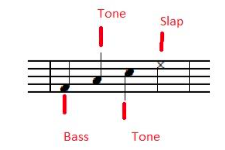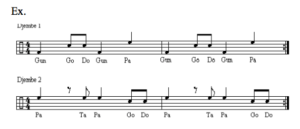-
Strange Humors By: John Mackey
Background
As a graduate student at Julliard, John Mackey composed Strange Humors for string quartet and djembe. The piece was soon adapted and performed by Parsons Dance Company and later was commissioned by the American Bandmasters Association and premiered in 2006. The purpose of the piece is to represent two African cultures, that of Egyptian (melodic) and West African (rhythmic). Jake Wallace goes on to describe the composition:
“The piece opens with a sultry English horn solo, a line laced with Phrygian influence representing the “typical” melodies of the most northeastern parts of the African continent—most notably Egypt, but also parts of the Arabia peninsula. Later, the saxophones emulate the snaking lines of the English horn. The addition of brass and auxiliary percussion to the original orchestration makes for particular impact during the shout sections of the piece, and the groove of the djembe combined with the quirky rhythms throughout leave an impression that lingers in the listener’s mind long after its conclusion.” (http://www.ostimusic.com/HumorsWinds.php)
Notation and Special Techniques
As the original arrangement is written for string quartet and Djembe, the Djembe part is a key part to the band arrangement. It’s important to have a strong djembe player that is familiar with advanced technique and rhythms. Mackey uses
 a traditional 5 line staff to notate the djembe part. Instead of one ‘tone’, there are two tones; one tone is to be the higher pitch an other tone is the lower pitch. In addition to this there is a ‘deadstroke’ (notated by a written deadstroke above note) that is to be played as a slap while the opposite hand is on the drum to dampen the sound.
a traditional 5 line staff to notate the djembe part. Instead of one ‘tone’, there are two tones; one tone is to be the higher pitch an other tone is the lower pitch. In addition to this there is a ‘deadstroke’ (notated by a written deadstroke above note) that is to be played as a slap while the opposite hand is on the drum to dampen the sound.Throughout the composition, Mackey uses aleatoric notation in both wind and percussion parts. These sections are to be played at the discretion of performers. The performance of these sections gives the piece authenticity, uniqueness, and expressive opportunities for individual performers
Performance Considerations
The piece is arranged for piccolo, two flutes, oboe, English horn, two bassoons, contrabassoon, E-flat clarinet, two B-flat clarinets, bass clarinet, Bb contra bass clarinet, soprano saxophone, alto saxophone, tenor saxophone, baritone saxophone, four B flat trumpets, four French horns, three trombones, euphonium, tuba, double bass, and 5 percussionists. Mackey gives cues throughout the piece to give added support to solo instruments and also allow for substitute instrumentation. There are many solo or exposed parts throughout the piece and requires strong lead players in each section.
The Djembe part features repeated rhythms that often alternate measure to measure. The difficulty of the djembe part is mastering the different strokes or tones. The rhythms, for an advanced high school student are straight forward. See “Notation” for specific concerns with the notation and the different tones.
I have listened to multiple recordings of the band arrangement and find it difficult to hear the Djembe as pronounced as in the original arrangement. Mackey suggest bringing the Djembe player to the front of the ensemble to sit in the first row. While this might help I believe the there are two options to make the Djembe more pronounced. The first would be to simply mic the drum on stage for performance. Depending on the size of the band, the Djembe can be easily drowned out by a large ensemble. The second option would be to put multiple Djembe players on the part. The challenge here is to find multiple percussionists that are advanced enough to play the part while having percussionist that can cover the remaining parts.
Mackey suggests that the bass drum part can be replaced with a “lower pitched Djembe”. In this case a dundun would be ideal. However, a Djembe player(s) playing just bass tones might be sufficient. If Djembes are not available, a hand drum such as conga or bongo can be substituted. However if this is done the distinct bass tones of the djembe will be lost. I would suggest using a traditional bass drum to balance the three traditional tones.
Melody, Harmony, Rhythm, Timbre Elements
The piece is primarily in G minor, however, it often explores different modes, such as Phrygian, to give the “exotic” sounds. Dissonances are used throughout the piece and should be addressed as a lesson for tuning in rehearsal. The melody is often played by a solo instrument or a couple instruments. In contrast to the harmony or accompaniment, the melodies feature lyrical phrases to offset the busy and complex rhythms. This is similar to the singing over traditional West African drumming.
The harmony, similar to the melody, is in G minor. The harmonic effect is a modal tune without the traditional or obvious western cadences. However, there are many tensions and releases throughout the piece that along with the dynamic changes offers grounding for the listener.
Rhythm is at the center of the piece and offers the most complexity to learning/teaching the piece. The rhythms are recurrent and should be taught to reflect this. The rhythmic patterns are often phrased in sections throughout the piece and often appear unison across multiple instruments.
Instrument timbre is clearly notated in the piece by means of articulation marking and special instructions from the composer. Overall, the timbre should mimic the sounds of the djembe, with distinct basses, tones, and slaps. In other words, wind instruments are asked to play percussive and aggressive throughout the piece.
Teaching Strategies (11th and 12th Grade)
- Strange Humors is rated as a grade 4 and is written for an advanced high school concert band. Realistically, this piece would best fit a high school honors band, or collegiate band. Written originally for string quartet it would be best to first play a recording of the string quartet to give students an understanding of the original intent. After listening to the original recording, students would listen to the band arrangement and reflect on the differences and similarities String Quartet Recording: http://www.ostimusic.com/Humors-media.php
- Before handing out the music, students should learn about traditional West African drumming. First, students would explore the history of West African drumming with emphasis on the djembe by researching a brief background and recording/videos and writing a brief report to share and submit for a grade.
- As part of a class discussion and presentation of students’ reports, I would lead the class with a presentation of the Djembe. Students will learn the various tones of the djembe and draw connections to articulations on their respected instruments. Students would participate in a call and response activity to both learn traditional rhythms and mimic the various tones (bass, tone, slap, etc) on their instrument.

- At this point I would hand out the music to students and begin with learning the coda (where students are all unison). Students would sing, clap (or drum), and play isolated rhythms. An in class activity for students would be to identify within the music the different “tones” or articulations that appear in the unison rhythms. This would be a good chance for students to draw connections between their western cultural experience of sounds and that of West Africa.
- The second challenge to this piece is the non-traditional techniques such as the pitch bends, falls, and various articulations. To better grasp these techniques, students would be given physical representations on how to play each technique. Common among woodwind players is to move in the motion of the articulation. If there is a pitch bend, the student would move to his/her horn to mimic this bend.
- As discussed in the harmonic analysis, the dissonances provide a challenge for students in that they are not usually written in the traditional canon. The best practices for introducing dissonances would be to first identify where they appear and their role (does it resolve?). Then isolate the dissonances and sing parts individually and together.
- Have the students understand the balance and importance of parts. Similar to music of West Africa, this piece is written to have layers. The layers are built on repeating rhythms (ostinatos), and often the effect of the piece is to have no one important line or idea in the piece; the overall grove and how the parts fit together is more important than just one part. Similarly, have students understand the importance of the embellishments such as grace notes and articulations.
- Additional activities could include making connections to other art forms. As this piece was adapted for dance, students would draw upon the artistic connections between musical and non-musical traditions. Students could draw upon West African traditions and the ceremonial dance traditions connected to the djembe.
- As a final project, students would perform and write program notes. A contest for the best would be chosen to be included in the concert program. The concert notes would encapsulate both the historic concepts and performance concepts learned over the unit.
